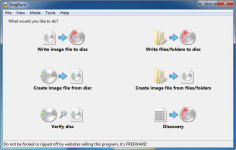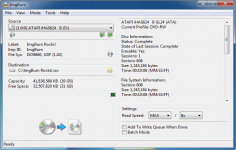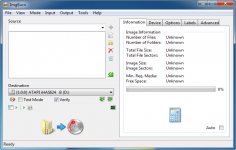 ImgBurn 2.5.5.0
ImgBurn 2.5.5.0
Lightning UK - (Freeware)
ImgBurn is a great solution software specialized in burning disc images that supports a wide variety of formats.
ImgBurn is an effective tool , which is developed to allow to burn any type of CD or DVD images, erase or reformat rewritable files. Regarding images that have support for dual-layer DVD, the application proposes to calculate the point of change layer in order to make optimal burning.
ImgBurn supports major image formats: ISO, IMG, BIN, DI, DVD, GI, MDS, NRG, PDI or LST.
The interface is reduced to the minimum necessary: select one or more images to be etched, the etching rate, the number of copies, select or clear the check and test mode and start the process by clicking the button pretty huge so that no one misses.
Imgburn can burn multiple images through a queue and can be shared by multiple burners.
- Title:
- ImgBurn 2.5.5.0
- File Size:
- 5.3 MB
- Requirements:
- Windows (All Versions)
- Language:
- en-us
- License:
- Freeware
- Date Added:
- 13 Jan 2011
- Publisher:
- Lightning UK
- Homepage:
- http://www.imgburn.com
- MD5 Checksum:
- 2EE60CADA64D2BE565DE78569D54130E
* Added: Support for Plextor PX-870 / PX-880 / PX-L890 drives to be treated as LiteOn drives (rather than true Plextor drives) by the 'Book Type' / 'Advanced Settings' code. This negates the need to manually enter the Device IDs in the 'Configure Drive OEM' window.
* Added: Support for /NOSAVELOG command line switch (see ReadMe.txt for usage).
* Added: Support for /FILESYSTEMONLY command line switch (see ReadMe.txt for usage).
* Added: Support for relative paths when reading the boot image file name from an IBB file.
* Added: Proper support for CDI images (including multi-track/session ones) via Padus's PfcToc.dll file (must be present where ImgBurn.exe is).
* Changed: Show a little more firmware version information for LG drives on the Device Capabilities window and when checking for firmware updates. This is useful for drives like the BH10LS30 that display 1.00 when the full version number might actually be 1.00-A9.
* Changed: Increased precision of timestamps when 'building' UDF file system.
* Changed/Fixed: DLL loading method to avoid Microsoft Security Advisory (2269637).
* Fixed: An internal table containing file system info during a Read/Verify operation was using an incorrect size value for files when UDF was being used and the files had multiple allocation descriptors spread over multiple sectors. (Only used when logging which file a certain bad sector belongs to)
Related software
2.0/5 from 178 users


